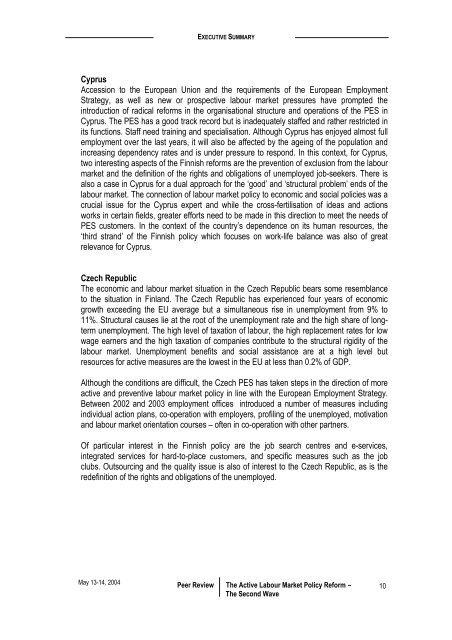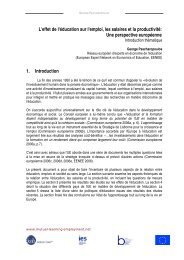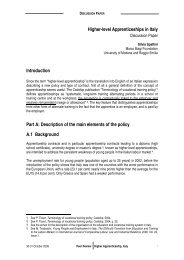The Active Labour Market Policy Reform – The Second Wave
The Active Labour Market Policy Reform – The Second Wave
The Active Labour Market Policy Reform – The Second Wave
Create successful ePaper yourself
Turn your PDF publications into a flip-book with our unique Google optimized e-Paper software.
May 13-14, 2004<br />
EXECUTIVE SUMMARY<br />
Cyprus<br />
Accession to the European Union and the requirements of the European Employment<br />
Strategy, as well as new or prospective labour market pressures have prompted the<br />
introduction of radical reforms in the organisational structure and operations of the PES in<br />
Cyprus. <strong>The</strong> PES has a good track record but is inadequately staffed and rather restricted in<br />
its functions. Staff need training and specialisation. Although Cyprus has enjoyed almost full<br />
employment over the last years, it will also be affected by the ageing of the population and<br />
increasing dependency rates and is under pressure to respond. In this context, for Cyprus,<br />
two interesting aspects of the Finnish reforms are the prevention of exclusion from the labour<br />
market and the definition of the rights and obligations of unemployed job-seekers. <strong>The</strong>re is<br />
also a case in Cyprus for a dual approach for the ‘good’ and ‘structural problem’ ends of the<br />
labour market. <strong>The</strong> connection of labour market policy to economic and social policies was a<br />
crucial issue for the Cyprus expert and while the cross-fertilisation of ideas and actions<br />
works in certain fields, greater efforts need to be made in this direction to meet the needs of<br />
PES customers. In the context of the country’s dependence on its human resources, the<br />
‘third strand’ of the Finnish policy which focuses on work-life balance was also of great<br />
relevance for Cyprus.<br />
Czech Republic<br />
<strong>The</strong> economic and labour market situation in the Czech Republic bears some resemblance<br />
to the situation in Finland. <strong>The</strong> Czech Republic has experienced four years of economic<br />
growth exceeding the EU average but a simultaneous rise in unemployment from 9% to<br />
11%. Structural causes lie at the root of the unemployment rate and the high share of longterm<br />
unemployment. <strong>The</strong> high level of taxation of labour, the high replacement rates for low<br />
wage earners and the high taxation of companies contribute to the structural rigidity of the<br />
labour market. Unemployment benefits and social assistance are at a high level but<br />
resources for active measures are the lowest in the EU at less than 0.2% of GDP.<br />
Although the conditions are difficult, the Czech PES has taken steps in the direction of more<br />
active and preventive labour market policy in line with the European Employment Strategy.<br />
Between 2002 and 2003 employment offices introduced a number of measures including<br />
individual action plans, co-operation with employers, profiling of the unemployed, motivation<br />
and labour market orientation courses <strong>–</strong> often in co-operation with other partners.<br />
Of particular interest in the Finnish policy are the job search centres and e-services,<br />
integrated services for hard-to-place customers, and specific measures such as the job<br />
clubs. Outsourcing and the quality issue is also of interest to the Czech Republic, as is the<br />
redefinition of the rights and obligations of the unemployed.<br />
Peer Review <strong>The</strong> <strong>Active</strong> <strong>Labour</strong> <strong>Market</strong> <strong>Policy</strong> <strong>Reform</strong> <strong>–</strong><br />
<strong>The</strong> <strong>Second</strong> <strong>Wave</strong><br />
10





